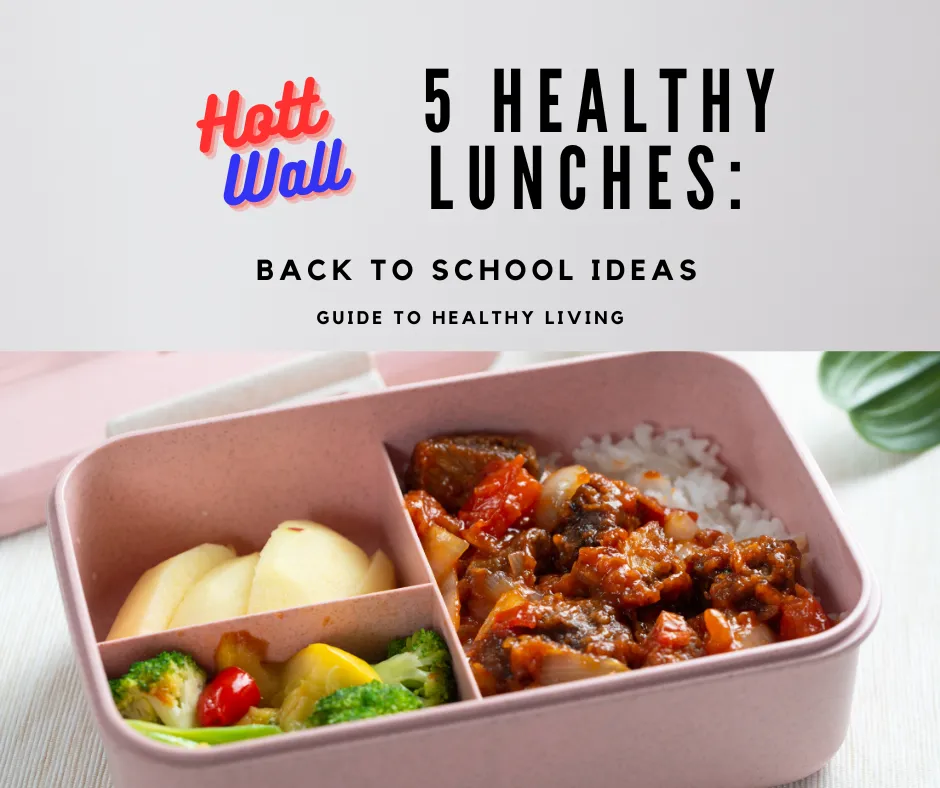
1. Introduction
Importance of Nutritious School Lunches
As the back-to-school season approaches, ensuring your child has a nutritious lunch is more important than ever. A well-balanced meal can fuel your child’s day, keeping them energized and focused during school hours. With the demands of modern life, it can be challenging to find the time and inspiration to prepare healthy lunches. However, with a bit of creativity and planning, you can provide your child with meals that are both delicious and packed with essential nutrients.
Overview of the Article
This article will guide you through five nutritious and easy-to-prepare lunch ideas that are perfect for busy parents. From repurposing leftovers to creating vibrant salads and smoothie bowls, these recipes are designed to be both kid-friendly and nutritionally balanced. Additionally, we’ll explore expert insights on child nutrition and share practical tips for making lunchtime preparation more manageable.
Table of Contents

1. Introduction
Importance of Nutritious School Lunches
As the back-to-school season approaches, ensuring your child has a nutritious lunch is more important than ever. A well-balanced meal can fuel your child’s day, keeping them energized and focused during school hours. With the demands of modern life, it can be challenging to find the time and inspiration to prepare healthy lunches. However, with a bit of creativity and planning, you can provide your child with meals that are both delicious and packed with essential nutrients.
Overview of the Article
This article will guide you through five nutritious and easy-to-prepare lunch ideas that are perfect for busy parents. From repurposing leftovers to creating vibrant salads and smoothie bowls, these recipes are designed to be both kid-friendly and nutritionally balanced. Additionally, we’ll explore expert insights on child nutrition and share practical tips for making lunchtime preparation more manageable.
2. Leftover Powerhouse
How to Repurpose Leftovers for Lunch
Repurposing leftovers is a time-saving and economical way to prepare school lunches. Instead of letting dinner leftovers go to waste, you can easily transform them into a nutritious meal for your child’s lunchbox. For instance, grilled chicken from dinner can be sliced and paired with whole-grain crackers, cheese, and fruit to create a balanced meal. Pasta from the previous night can be mixed with fresh vegetables and a light dressing for a quick and tasty pasta salad.
Nutritional Benefits of Leftover Meals
Leftover meals often contain a variety of food groups, which helps ensure that your child gets a balanced intake of proteins, carbohydrates, and vegetables. By repurposing leftovers, you can also introduce your child to a wider range of flavors and textures, which can be beneficial for expanding their palate. Moreover, this approach reduces food waste, making it a sustainable choice for your family.
3. Sandwich Surprise
Choosing Whole-Grain Options
When it comes to preparing sandwiches, choosing whole-grain bread or wraps is a simple but effective way to boost the nutritional value of your child’s lunch. Whole grains are rich in fiber, which aids digestion and helps keep kids full longer. They also provide essential vitamins and minerals that refined grains lack. Look for breads labeled “100% whole grain” or “whole wheat” to ensure you’re making the healthiest choice.
Creative Fillings for Nutritious Sandwiches
The beauty of sandwiches is their versatility. You can fill them with a variety of nutritious ingredients to keep lunchtime exciting. For a protein-packed option, consider using lean turkey or chicken breast paired with fresh vegetables like lettuce, tomatoes, and cucumbers. Adding avocado or hummus not only enhances the flavor but also provides healthy fats that are crucial for brain development. For a vegetarian option, try a combination of roasted vegetables, hummus, and feta cheese.
4. Salad Sensation
Building a Balanced Salad
Salads are a fantastic way to pack a variety of nutrients into a single meal. Start with a base of leafy greens like spinach or kale, which are rich in vitamins A and C, as well as iron. Add a source of protein, such as grilled chicken, beans, or tofu, to keep your child full and energized. Incorporate colorful vegetables like bell peppers, carrots, and cherry tomatoes for added vitamins and antioxidants. For a carbohydrate boost, include a small portion of whole grains like quinoa or brown rice.
Tips for Keeping Salads Fresh in Lunchboxes
One of the challenges of packing salads for school is ensuring they stay fresh until lunchtime. To prevent sogginess, keep the dressing separate and add it just before eating. You can use small, leak-proof containers for this purpose. Additionally, layering the salad with heavier ingredients at the bottom and greens on top can help maintain texture. Consider using a bento box or compartmentalized lunch container to keep ingredients separate until it’s time to eat.
5. Bento Box Bliss
What is a Bento Box?
A bento box is a Japanese-style lunchbox that typically contains small portions of a variety of foods. This approach to packing lunch is not only visually appealing but also encourages balanced eating. By offering different types of food in one meal, you can ensure that your child is getting a range of nutrients. Bento boxes often include rice, proteins like fish or chicken, vegetables, and fruit, making them a well-rounded option for school lunches.
Creating a Balanced Bento Box
To create a balanced bento box, start by selecting a grain, such as brown rice or whole-grain noodles. Add a source of protein, like grilled chicken, tofu, or hard-boiled eggs. Include a variety of vegetables, such as steamed broccoli, cherry tomatoes, or carrot sticks, to add color and nutrients. For dessert, consider adding a piece of fruit or a small portion of yogurt. The key to a successful bento box is variety—aim to include different colors, textures, and flavors to make the meal more appealing.
6. Smoothie Bowl Power-Up
Ingredients for a Nutrient-Packed Smoothie Bowl
Smoothie bowls are a great option for a lunch that feels like a treat but is packed with nutrients. Start with a base of blended fruits like bananas, berries, and a handful of spinach or kale. Adding a protein source, such as Greek yogurt or a scoop of protein powder, will help keep your child full longer. You can also include healthy fats by blending in some avocado or a tablespoon of nut butter.
Toppings to Boost Nutrition and Flavor
The toppings are where you can really customize a smoothie bowl to your child’s taste while adding extra nutrients. Consider adding sliced bananas, fresh berries, or a sprinkle of granola for crunch. Chia seeds, flaxseeds, and nuts are excellent sources of omega-3 fatty acids, which are important for brain health. For a touch of sweetness, drizzle a bit of honey or add a few pieces of dark chocolate.
7. Veggie-Packed Pasta Salad
How to Make a Veggie-Packed Pasta Salad
Pasta salad is a versatile and filling lunch option that can be packed with a variety of vegetables to ensure your child gets plenty of nutrients. Start with whole-grain or chickpea pasta for added fiber and protein. Add a mix of colorful vegetables like cherry tomatoes, bell peppers, cucumbers, and spinach. For protein, consider adding grilled chicken, chickpeas, or mozzarella cheese. Toss everything in a light vinaigrette made with olive oil, lemon juice, and herbs for a burst of flavor.
Nutritional Benefits of Pasta Salad
This veggie-packed pasta salad is not only delicious but also provides a balanced mix of carbohydrates, proteins, and healthy fats. The whole-grain or chickpea pasta offers sustained energy, while the variety of vegetables supplies essential vitamins and minerals. This dish is also easy to customize, making it a great way to use up any leftover vegetables in your fridge.
8. Expert Insights on Child Nutrition
Quotes from Pediatric Nutritionists
According to Dr. Jane Smith, a pediatric nutritionist, “A balanced lunch that includes a mix of protein, healthy fats, and complex carbohydrates can significantly impact a child’s energy levels and concentration throughout the school day.” She emphasizes the importance of including a variety of foods to ensure children get a broad spectrum of nutrients.
The Role of Balanced Meals in Academic Performance
Research has shown that children who consume balanced meals are more likely to perform well academically. Proper nutrition supports cognitive function, memory, and concentration, all of which are crucial for learning. Ensuring that your child has a nutritious lunch can help them stay focused and engaged in their schoolwork.
9. Practical Tips for Busy Parents
Meal Prepping for the Week
Meal prepping can save you time and stress during the busy school week. Set aside some time on the weekend to prepare ingredients like grilled chicken, chopped vegetables, and cooked grains. These can be stored in the refrigerator and assembled into lunches throughout the week. Prepping in advance allows you to quickly pack a healthy lunch each morning without the rush.
Involving Kids in the Lunch-Making Process
Getting your children involved in preparing their lunches can make them more excited about eating healthy. Allow them to choose from a selection of healthy ingredients or help them assemble their own bento box. This not only teaches them about balanced eating but also gives them a sense of ownership over their meals, which can reduce lunchtime battles.
10. Emerging Trends in School Lunches
The Rise of Plant-Based Lunches
Plant-based diets are becoming increasingly popular, and this trend is extending to school lunches. Many parents are opting for vegetarian or vegan meals that are rich in vegetables, legumes, and whole grains. Plant-based lunches can be just as filling and nutritious as those that include meat, and they offer the added benefits of being lower in saturated fat and cholesterol.
Incorporating Global Flavors
Introducing global flavors into your child’s lunchbox is a great way to expand their palate and make lunchtime more exciting. Consider adding dishes inspired by cuisines from around the world, such as Mexican-inspired quinoa bowls, Mediterranean wraps, or Asian-style noodle salads. These dishes can be both nutritious and a fun way to explore new flavors.
11. Conclusion
Recap of Key Points
Packing a healthy and delicious lunch for your child doesn’t have to be a daunting task. By repurposing leftovers, getting creative with sandwiches, and exploring options like salads, bento boxes, and smoothie bowls, you can ensure your child enjoys a variety of nutritious meals. Involving your child in the lunch-making process and staying informed about nutrition trends can make this task even more manageable and fun.
Encouragement to Try New Recipes
Don’t be afraid to experiment with new recipes and flavors. A diverse diet is not only more enjoyable but also ensures that your child is receiving a wide range of nutrients. With a little planning and creativity, you can make lunchtime a highlight of your child’s school day.
FAQ: Healthy Back-to-School Lunches
What are some quick and easy lunch ideas for kids?
Quick and easy lunch ideas include sandwiches made with whole-grain bread and lean proteins, leftover meals from dinner, and simple salads with a variety of vegetables and a protein source. Bento boxes filled with small portions of different foods and smoothie bowls topped with fruits and nuts are also great options.
How can I ensure my child’s lunch stays fresh until lunchtime?
To keep your child’s lunch fresh, use insulated lunch bags and ice packs to maintain the temperature. For salads, keep the dressing separate in a small container to avoid sogginess. Consider packing ingredients like sandwiches, fruits, and snacks in airtight containers to preserve freshness.
What are some healthy snack options to include in a lunchbox?
Healthy snack options include sliced fruits, vegetables with hummus, yogurt, nuts, whole-grain crackers, and cheese. You can also pack homemade energy balls or granola bars made with oats, honey, and dried fruits for a nutritious treat.
How do I encourage my child to eat their lunch at school?
Involving your child in the lunch-making process can help them feel more excited about eating their lunch. Let them choose their favorite healthy ingredients or help them pack their lunchbox. Additionally, variety is key—rotate different foods and flavors to keep lunchtime interesting.
What are some plant-based lunch ideas for kids?
Plant-based lunch ideas include wraps or sandwiches with hummus and vegetables, quinoa or rice bowls with beans and roasted veggies, pasta salads with a variety of vegetables, and tofu stir-fries. Smoothie bowls topped with nuts, seeds, and fruits also make for a filling and nutritious plant-based lunch.








